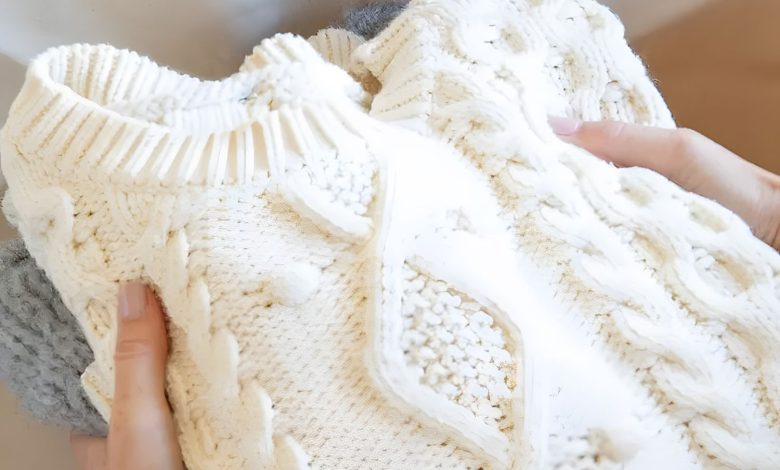Shrinking Clothes without Damage: Tips from Textile Experts

Laundry can be stressful. It’s easy to misread the tags and wash or dry clothes on the wrong setting, which can change the way the piece looks, feels, and fits. Cold water may not be as effective at removing viruses from garments as hot water, and it is possible that cold water will fade dark colors. This is still a matter of debate. A normal cycle can work well for jeans and tees but can be too harsh for delicate items such lingerie or silk. Understanding the different effects of washing your clothes can be helpful if you want to change your item in the wash. spoke to two fabric experts for their tips on shrinking clothes at home. They also shared fabric considerations and precautions.
Why do Clothes shrink in the wash?
Some garments shrink when washed, but not all. When garments and fabrics are stressed and strained during the manufacturing process, shrinkage is a result of them trying to get back to their relaxed, un-stressed condition . This is explained by Downy Senior Scientist Sammy Wang.
How can you tell which items are likely to shrink? Wang explains that while fabrics shrink to their equilibrium in general, several factors can affect the type and amount of shrinkage. These include fiber type, fabric construction, and drying method. Cotton, linen, wool and silk are fibers that tend to shrink more easily. Drying on high heat will also cause more shrinkage.
Can I shrink my clothes at home?
Wang says that it is not as simple as following the instructions on the label. She says that because there are many different types of clothing and many variables involved, it’s impossible to predict exactly how a garment will shrink or change. Therefore, she doesn’t recommend shrinking clothes intentionally. To take care of your clothing, follow the instructions provided on the label.
Fabric Considerations
Some fabrics shrink more than others. Wang says that cellulosic fibres such as cotton or rayon will shrink more easily when machine washed and dried at a higher temperature. Synthetic fibers such as polyester, nylon spandex and elastane, are less likely than cotton or rayon to shrink. You can still try machine-washing and drying at a high heat, but you may not get the desired shrinkage.
Fabric construction also affects how susceptible the fabric is to shrinkage. Wang explains that knit fabrics, such as T-shirts or sweaters, shrink more due to the more space between the fibers. However they are also more elastic and can recover their shape much more easily. Dress pants, for example, are less likely than knit fabrics to shrink due to their tight weave. However they will not be able regain shape as quickly as a knitting.
Wool can shrink significantly, but it can also cause irreparable harm. Wang warns that wool meant for dry cleaning should not be machine washed as it will shrink excessively. Wool shrinks when it is exposed to heat, moisture and agitation, which all occur during machine washing and drying. While you may notice a slight change in size, the shrinkage may be so extreme that it makes the item unwearable.
Precautions
We want to emphasize that shrinking clothes at home is not an easy solution. Wang says that because of all the variables, it is difficult to predict or control the shrinkage of clothes when shrinking them at home. However, shrinkage can range from a 10% reduction in size to as much as a 30% decrease. Some manufacturers pre-shrink fabrics to ensure that they won’t shrink at all. However, if this isn’t advertised, it’s impossible to know if the garment has been pre-shrunk. You may damage clothes even though you don’t see any shrinkage.
How to shrink clothes at home
We understand that you may want to try it anyway, even though it’s not recommended. Your garment could shrink in ways that you didn’t expect. For example, the width of the garment might shrink but not the overall length. You’ll learn four different ways to shrink clothes at home.
- Turn the heat up: “If you want your clothes to shrink on purpose, then the best way to achieve this is to use the washing machine and dryer at high temperatures, since heat is the main method of shrinking clothing,” says Frej Lewenhaupt, co-founder and CEO of Steamery and textile expert. “I don’t recommend shrinking clothing because it is a waste of energy, can be harsh and cause clothes to lose their color, shape and luster.”
- Know the fabric:Not every garment shrinks in the dryer or washer. Wang recommends experimenting with natural fibers to give yourself the best chances of success. She explains that natural fibers, such as cotton, shrink the most because they are hydrophilic (or ‘water-loving.’) They tend to absorb water and swell and contribute to shrinkage. If you want to shrink polyester, it won’t change shape in the washing machine unless it is blended with a fiber that loves water.
- Wash at a high soil-level: Altering the level agitation of your washing machine is another way to manipulate garments. The higher the soil setting you choose, the longer your machine will soak fabrics and the more agitation it will do. Wang explains that hot water isn’t always needed because water saturation and agitation create conditions where cotton shrinks during the wash cycle. You can therefore wash your clothes at the recommended temperature and then increase the intensity. Wang says that the water and agitation in the washing process, as well as the mechanical tumbling during machine drying, will cause the fibers to shrink. The higher heat and agitation of the dryer can also help “set” the shrinkage. You can repeat the process multiple times to achieve your desired result.
- Soak clothes in boiling hot water: The water that a washing machine creates may be hot but not boiling. Some TikTokers claim that boiling water in a stainless-steel bowl will enhance shrinkage at home. Submerge your garment in boiling water for at least 20 minutes. Then, using tongs to squeeze out the excess water and then tumble-dry it on high heat.
Can you undo clothing shrinkage?
It’s possible to get the wrong result even if you carefully follow all of the instructions above. Wang explains that it’s impossible to know how a garment will behave by simply looking at the fabric. This is why Wang doesn’t recommend shrinking clothing at home. If you accidentally shrink something, however, there are some ways to fix the problem. Check out the steps below.
- Create your own solution: “Fill up a bucket with water at room temperature and add a half cap of fabric conditioner, thoroughly mixing it in. The fabric softener lubricates and conditions the fibers to allow them to move more easily,” Wang says.
- Let the fabric sit: Allow the solution to work on the fabric. Wang says to soak and saturate the garment for 15 minutes in the solution, and then rinse it gently with cold water.
- Let your garment air dry: After removing your garment and wringing it out, gently stretch and let it dry on a flat or drying rack. Wang says that for future washings, we should always follow the instructions on the label.
Takeaway
Although adjusting the settings on your washing machine and trying different soaking methods may shrink or alter your clothing, it is not recommended as you do not know what will happen. You should have a tailor make the garment smaller if you want to. If you follow the steps above carefully and are careful, you will have a greater chance of shrinking your clothing at home. This is because if the instructions were reversed, it would be impossible to achieve the desired result. You should proceed slowly and with caution.




